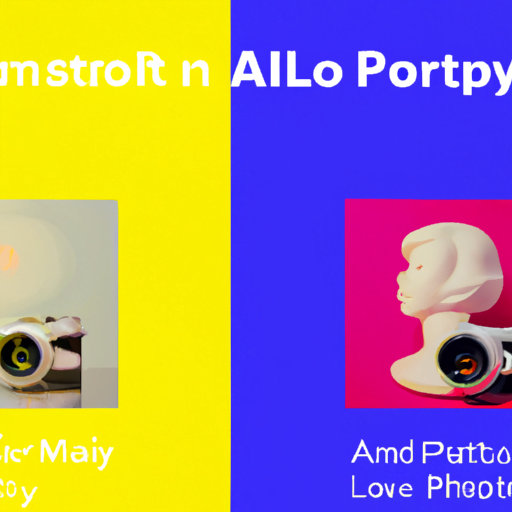
-
Table of Contents
- Transforming Stock Photography with AI-Personalized Imagery
- The Limitations of Traditional Stock Photography
- The Rise of AI-Personalized Imagery
- The Benefits of AI-Personalized Imagery
- 1. Enhanced Diversity and Representation
- 2. Authentic and Engaging Visuals
- 3. Time and Cost Savings
- 4. Increased Originality and Uniqueness
- The Future of AI-Personalized Imagery
- Conclusion
Transforming Stock Photography with AI-Personalized Imagery

Stock photography has long been a valuable resource for businesses and individuals seeking high-quality images to enhance their marketing materials, websites, and social media posts. However, the traditional approach to stock photography often falls short in meeting the diverse and specific needs of users. Enter AI-personalized imagery, a revolutionary technology that is transforming the stock photography industry. In this article, we will explore how AI is reshaping the world of stock photography, the benefits it offers, and the potential it holds for the future.
The Limitations of Traditional Stock Photography
Traditional stock photography platforms have been a go-to resource for businesses and individuals looking for images to accompany their content. However, these platforms often suffer from several limitations:
- Lack of diversity: Traditional stock photography libraries have historically been criticized for their lack of diversity, with a majority of images featuring Caucasian models. This limited representation fails to reflect the multicultural reality of our society.
- Generic and staged imagery: Many stock photos feel staged and lack authenticity, making it challenging for businesses to connect with their target audience on a deeper level.
- Repetitive content: Stock photography platforms often feature the same images across multiple websites, resulting in a lack of originality and uniqueness.
- Time-consuming search process: Locating the perfect image from a vast collection of stock photos can be a time-consuming task, requiring users to sift through numerous irrelevant images.
The Rise of AI-Personalized Imagery
Artificial Intelligence (AI) has emerged as a game-changer in the stock photography industry, addressing the limitations of traditional stock photography platforms and revolutionizing the way images are created and delivered. AI-personalized imagery leverages machine learning algorithms to generate images that are tailored to the specific needs and preferences of users.
One notable example of AI-personalized imagery is the work of the company Generated Photos. They have developed an AI system capable of generating photorealistic images of people who do not exist. By training their AI on a vast dataset of real human faces, Generated Photos can create diverse and unique images of people that can be used in various contexts.
Another example is the use of AI to generate personalized product images. Platforms like Vue.ai utilize AI algorithms to create product images that showcase different variations, colors, and styles of a particular item. This enables businesses to display a wide range of options to their customers without the need for costly photoshoots.
The Benefits of AI-Personalized Imagery
The integration of AI-personalized imagery into the stock photography industry brings numerous benefits for both users and content creators:
1. Enhanced Diversity and Representation
AI-personalized imagery has the potential to address the lack of diversity in traditional stock photography. By generating images of people from various ethnicities, ages, and backgrounds, AI can provide a more accurate representation of our diverse society. This allows businesses to connect with a broader audience and create more inclusive marketing campaigns.
2. Authentic and Engaging Visuals
AI-personalized imagery can create visuals that feel more authentic and relatable. By generating images that are not staged or overly posed, businesses can establish a stronger emotional connection with their target audience. Authentic visuals have been proven to increase engagement and improve brand perception.
3. Time and Cost Savings
AI-personalized imagery eliminates the need for costly and time-consuming photoshoots. Businesses can now access a vast library of AI-generated images that cater to their specific requirements, saving both time and money. This allows for more agile and efficient content creation processes.
4. Increased Originality and Uniqueness
AI-personalized imagery reduces the risk of using repetitive and overused stock photos. By generating unique images, businesses can differentiate themselves from competitors and create a more memorable brand identity. This uniqueness can help capture the attention of consumers in a crowded digital landscape.
The Future of AI-Personalized Imagery
The potential of AI-personalized imagery extends beyond its current applications. As AI technology continues to advance, we can expect further developments in the field of stock photography:
- Improved Customization: AI algorithms will become more sophisticated in understanding user preferences, allowing for even more personalized and tailored imagery.
- Real-Time Image Generation: AI systems will be able to generate images on-demand, providing users with instant access to the visuals they need.
- Integration with Augmented Reality (AR) and Virtual Reality (VR): AI-personalized imagery can be seamlessly integrated into AR and VR experiences, creating immersive and interactive visual content.
- Expanded Application: AI-personalized imagery can be applied to various industries beyond marketing, such as gaming, e-commerce, and virtual simulations.
Conclusion
AI-personalized imagery is revolutionizing the stock photography industry by addressing the limitations of traditional platforms and offering a range of benefits for users and content creators. With enhanced diversity, authenticity, time and cost savings, and increased originality, AI-personalized imagery is reshaping the way businesses and individuals access and utilize visual content.
As AI technology continues to advance, we can expect even more exciting developments in the field of stock photography. The future holds the promise of improved customization, real-time image generation, integration with AR and VR, and expanded applications across various industries. Embracing AI-personalized imagery opens up a world of possibilities for businesses and individuals seeking visually compelling and tailored content.
